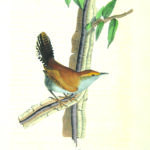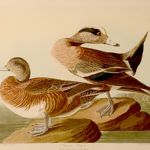Mark Catesby (1683–1749) was one of the first in a succession of naturalists who sought to illustrate in their art the ecological relationships between plants and animals. This interdependence would be fundamental to the hand-colored copper plate engravings he did for The Natural History of Carolina, Florida and the Bahama Islands, London, 1729–1747. Almost 100 years later, John James Audubon (1785–1851), assisted by his student Joseph R. Mason, accurately painted the environments in which to place the birds illustrated in The Birds of America, London, 1827–1838.
The exhibit features over sixty Catesby prints and Audubon Octavo prints from its collections that illustrate the integration of flora with birds and other animals, in the pull-out drawer case in the entrance to the Decorative Arts gallery.
- Bewick’s wren, 1840–1844, John James Audubon, Copperplate engraving, from Birds of America Octavo Edition.
- American Widgeon, Anas americana, hand colored aquatint engraving by Robert Havell, Jr. after John James Audubon
Mark Catesby (1683–1749) was one of the first in a succession of naturalists who sought to illustrate in their art the ecological relationships between plants and animals. This interdependence would be fundamental to the hand-colored copper plate engravings he did for The Natural History of Carolina, Florida and the Bahama Islands, London, 1729–1747. Almost 100 years later, John James Audubon (1785–1851), assisted by his student Joseph R. Mason, accurately painted the environments in which to place the birds illustrated in The Birds of America, London, 1827–1838.
The exhibit features over sixty Catesby prints and Audubon Octavo prints from its collections that illustrate the integration of flora with birds and other animals, in the pull-out drawer case in the entrance to the Decorative Arts gallery.


